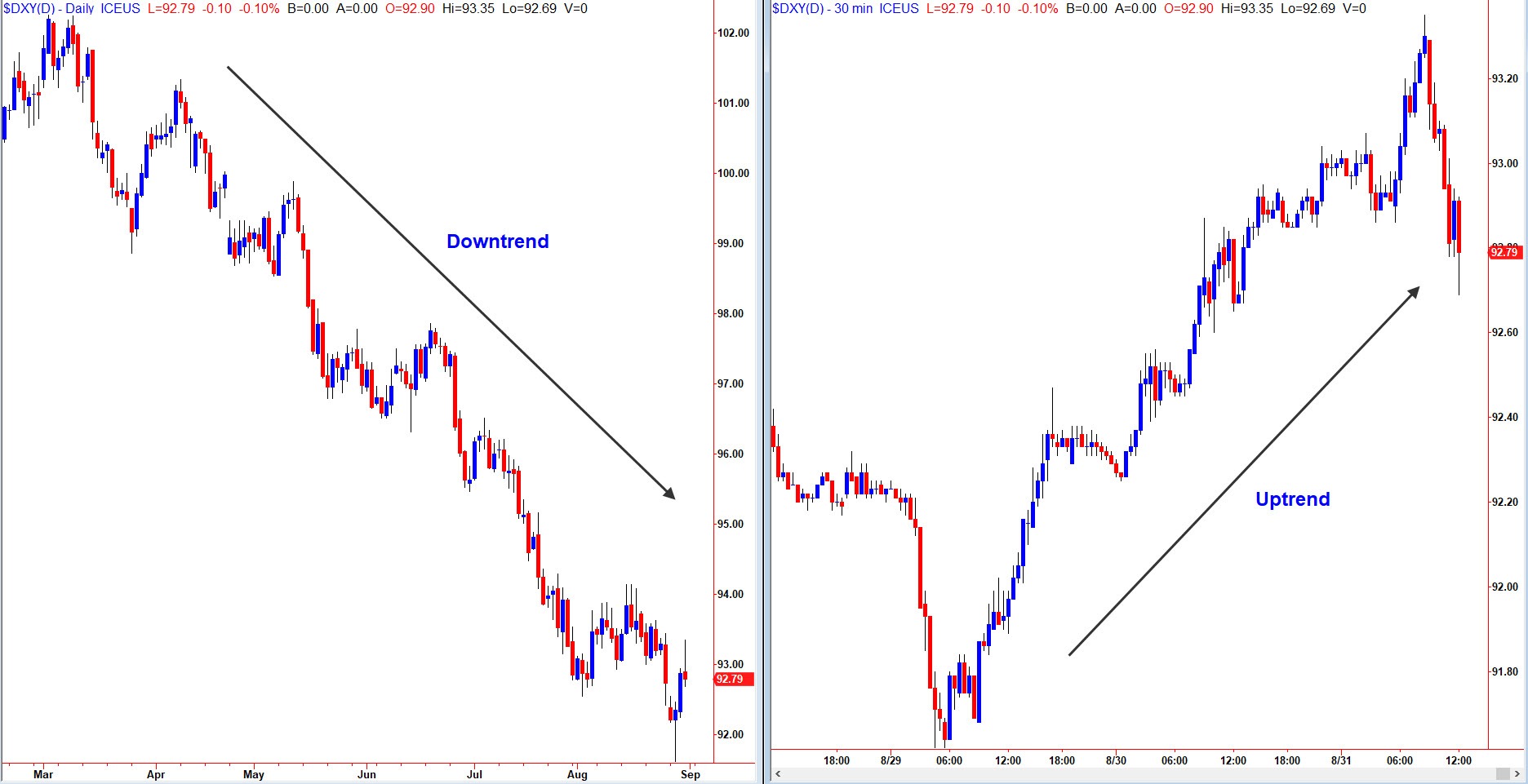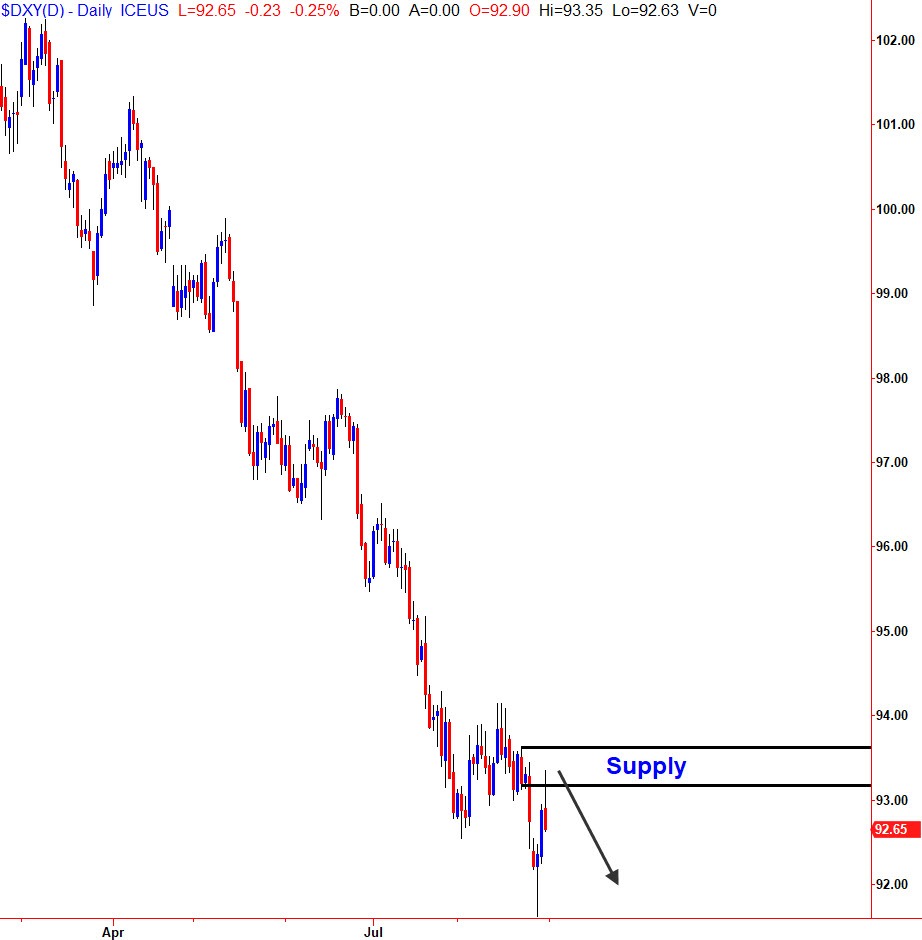Over the last month of leading the ongoing XLT FX sessions, we have been doing our usual business of analyzing the currency markets in real-time and scouting the arena for only the very best low risk and high potential reward setups we can find. Following on from a sharp decline in the value of the US Dollar over this last year, things seem to have settled down a little as this market in general goes through the next transition, trapped between key levels of Supply and Demand ahead of the next big move. With these conditions in mind, many of my students and peers alike have been talking about the current trend, a subject which often causes both mixed feelings or confusion, and frustration for many traders in these times of uncertainty for the Dollar.
In most mediums of trading education, we often hear or read the phrase “The Trend is Your Friend”. We are encouraged to follow the trend in our setups and strategies, being told that going with the momentum of current price action offers the best rewards and highest level of probability. While it is hard to deny that trends do indeed tend to continue for consistent periods of time, we also need to sit back and recognize that the matter of trend analysis can also be something very subjective in nature as well. No trend lasts forever, that’s why it’s called a trend. A trend it would simply be a certainty if it wasn’t, and there is no such thing as that in the price action of the financial markets. The issue most newer students of mine have is that they rely on lagging forms of trend analysis which only confirm that which has already happened. We also need to develop the skills to anticipate that which is likely to happen next.
The first hurdle seems to come from the many ways to define a trend in technical analysis studies, including the traditional methods of spotting higher highs, higher lows, lower highs and lower lows. Plus, we have such tools as moving averages and convergence/divergence analysis to aid us in the process too. All can be of great use to a trader, but these methods only confirm what has already happened across a very specific period of time as well. Perspective changes across various charts and we can see different pictures of the same thing if not careful. For example, in the below example we can see 2 trends of the same market:
When we say that something is in an uptrend or downtrend you must understand that the trend we are currently observing is only a picture of price action across the timeframe or period in which we are looking at, and often when we shift our attention to another viewpoint things can often look very different, as shown in the above shots of the Dollar Index across 2 charts. So which trend do I follow if the trend is meant to be my friend?
From the start of 2017, we have been enjoying a steady and progressive downward trend in the DXY (Dollar Index). We have witnessed consistent lower lows and lower highs, signaling weakness in this market. From this perspective alone it would make good sense to look for a pullback to sell short into this falling market. However, looking at the same market from a smaller chart, we are right now in an uptrend. So, what is the best plan, long or short? This is a common issue for the trend trader in that it can often be difficult to really know what the trend is going to produce next. Are we in an impulse move or a corrective one? Rather than confuse myself with these mixed market signals, I choose to follow a simpler approach. I look to the most recent buying and selling activity, quantified by institutional demand and supply imbalances.
In this chart, we can see the impact of the major banks selling at the established supply zone on the daily chart and, with an apparent lack of demand to meet the selling pressure, we would assume the price is going to continue lower for now because the trend has room to run:
With no clearly defined buying activity on this chart we must look further out to see where we can find the next institutional level of demand. This is our way of anticipating the next trend to come. By zooming out, we can see some solid buying from the big market players in the following area of demand:
By taking the demand/supply approach to the trend we are looking to anticipate each leg of the trend, both impulse and corrective, which can only be spotted by recognizing the footprints of the banks via supply and demand zones on a price chart. When we look to define a trend, we always need to remember that any trend we are currently looking at is a thing of the past. It is an illustration of something that has already happened so to therefore simply assume that it will continue can often result in frustration. I choose to objectively analyze the most recent examples of buying and selling activity within the market and let the behavior of price lead the way. Sure, sometimes I am wrong and it costs me a little, but when I am right it pays dividends, thus consistently guaranteeing me a solid overall risk to reward ratio. To say I am not a trend trader would be wrong. I do trade the trend but I look for an opportunity to be in the trend from the very start…
Have a great day.
Note: All information on this page is subject to change. The use of this website constitutes acceptance of our user agreement. Please read our privacy policy and legal disclaimer. Opinions expressed at FXstreet.com are those of the individual authors and do not necessarily represent the opinion of FXstreet.com or its management. Risk Disclosure: Trading foreign exchange on margin carries a high level of risk, and may not be suitable for all investors. The high degree of leverage can work against you as well as for you. Before deciding to invest in foreign exchange you should carefully consider your investment objectives, level of experience, and risk appetite. The possibility exists that you could sustain a loss of some or all of your initial investment and therefore you should not invest money that you cannot afford to lose. You should be aware of all the risks associated with foreign exchange trading, and seek advice from an independent financial advisor if you have any doubts.
Editors’ Picks
AUD/USD remained bid above 0.6500

AUD/USD extended further its bullish performance, advancing for the fourth session in a row on Thursday, although a sustainable breakout of the key 200-day SMA at 0.6526 still remain elusive.
EUR/USD faces a minor resistance near at 1.0750

EUR/USD quickly left behind Wednesday’s small downtick and resumed its uptrend north of 1.0700 the figure, always on the back of the persistent sell-off in the US Dollar ahead of key PCE data on Friday.
Gold holds around $2,330 after dismal US data

Gold fell below $2,320 in the early American session as US yields shot higher after the data showed a significant increase in the US GDP price deflator in Q1. With safe-haven flows dominating the markets, however, XAU/USD reversed its direction and rose above $2,340.
Bitcoin price continues to get rejected from $65K resistance as SEC delays decision on spot BTC ETF options

Bitcoin (BTC) price has markets in disarray, provoking a broader market crash as it slumped to the $62,000 range on Thursday. Meanwhile, reverberations from spot BTC exchange-traded funds (ETFs) continue to influence the market.
US economy: slower growth with stronger inflation

The dollar strengthened, and stocks fell after statistical data from the US. The focus was on the preliminary estimate of GDP for the first quarter. Annualised quarterly growth came in at just 1.6%, down from the 2.5% and 3.4% previously forecast.
RECOMMENDED LESSONS
Making money in forex is easy if you know how the bankers trade!
Discover how to make money in forex is easy if you know how the bankers trade!
5 Forex News Events You Need To Know
In the fast moving world of currency markets, it is extremely important for new traders to know the list of important forex news...
Top 10 Chart Patterns Every Trader Should Know
Chart patterns are one of the most effective trading tools for a trader. They are pure price-action, and form on the basis of underlying buying and...
7 Ways to Avoid Forex Scams
The forex industry is recently seeing more and more scams. Here are 7 ways to avoid losing your money in such scams: Forex scams are becoming frequent. Michael Greenberg reports on luxurious expenses, including a submarine bought from the money taken from forex traders. Here’s another report of a forex fraud. So, how can we avoid falling in such forex scams?
What Are the 10 Fatal Mistakes Traders Make
Trading is exciting. Trading is hard. Trading is extremely hard. Some say that it takes more than 10,000 hours to master. Others believe that trading is the way to quick riches. They might be both wrong. What is important to know that no matter how experienced you are, mistakes will be part of the trading process.




